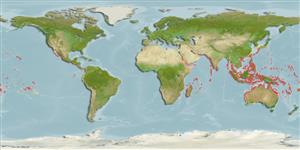Common names from other countries
Environment: milieu / climate zone / depth range / distribution range
Ecologia
; intervalo de profundidade 2 - 5 m (Ref. 101327). Tropical
Indo-Pacific: from East Africa to eastern Polynesia, not in the Red Sea, the Persian Gulf, nor the Gulf of Bengal; north to Japan and Hawaii, and south to central Queensland and New Caledonia.
Length at first maturity / Tamanho / Peso / Idade
Maturity: Lm ? range ? - ? cm Max length : 13.0 cm SHL macho/indeterminado; (Ref. 349); common length : 10.0 cm SHL macho/indeterminado; (Ref. 349)
Frequently in the Indo-West Pacific for food and shellcraft (Ref. 349). Depth range is based on occurrence in French Polynesia (Ref. 101327); to be replaced with a better reference. Under stones and in crevices of rocky headlands exposed to strong wave action (Ref. 349). Usually found among dark rocks (Ref. 799). Mostly active at night. Mainly inhabits shallow subtidal levels. Occurs at the low tide mark (Ref. 349). Most cypraeids are herbivores (Ref. 113307).
Life cycle and mating behavior
Maturidade | Reprodução | Desova | Ovos | Fecundidade | Larvas
Members of the order Neotaenioglossa are mostly gonochoric and broadcast spawners. Life cycle: Embryos develop into planktonic trocophore larvae and later into juvenile veligers before becoming fully grown adults.
Poutiers, J.M. 1998. (Ref. 349)
Categoria na Lista Vermelha da IUCN (Ref. 130435)
Categoria CITES (Ref. 108899)
Not Evaluated
Not Evaluated
Ameaça para o homem
Harmless
Utilização humana
Pescarias: espécies comerciais
| FishSource | Sea Around Us
Ferramentas
Mais informação
Idade/TamanhoCrescimentoComprimento-pesoComprimento-comprimentoMorfologiaLarvasAbundância
Fontes da internet
Estimates based on models
Preferred temperature
(Ref.
115969): 24.7 - 29.3, mean 28.4 (based on 3363 cells).
Vulnerabilidade
Low vulnerability (10 of 100).
Categoria de preço
Unknown.
